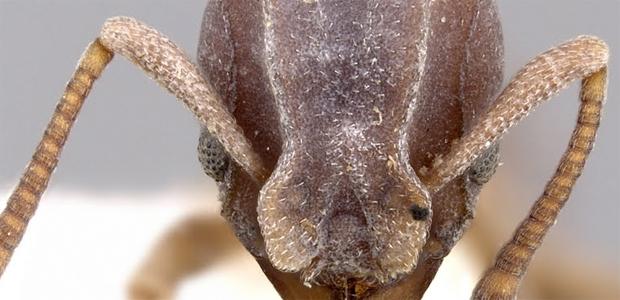Close-Up Photos of Ants Show Species Diversity
This ant species — Cyphomyrmex faunulus — actually farms its own fungus.
A team from the California Academy of Sciences is in the midst of what it calls its World Ant Tour, a 14-month journey to photograph thousands of ant specimens in high resolution and sharp focus. The images are being posted to a free website called AntWeb so anyone can study – or just admire – the world’s diversity of ants. Ari Daniel Shapiro of our partner program NOVA reports.
“These little ants [belong to] the genus Lazius,” Lieberman says. “You’ll find them anywhere that you go in London.”
Liam Ericson crouches beside him. “They’re very adaptable,” he adds. “They’re everywhere in this city.”
Ericson and Lieberman are part of a three-man team from California now touring Europe to look at ants.
But these two are not here to collect ants on the streets. They have come to explore what stands behind them – London’s famed Natural History Museum and its vast collection of ant specimens from all over the world.
Hidden Beauty
Zach Lieberman steps into one of the massive climate-controlled collection rooms at the museum.
“For an entomology nerd, it’s an honor to be able to work with a collection like this,” he says. “It’s heaven. Just thousands upon thousands upon thousands of specimens.”
Lieberman pulls out one of the 600 drawers filled with ants – each one pinned and labeled. He points to a species from South America that can grow one-and-a-half inches long.
“Oh yeah, Dinoponera – the largest ants in the world,” he says.
“Sometimes there [are] ants that you literally can’t see,” he says, “and then you get them under the microscope and it just opens up this whole world. That’s where a lot of the really hidden beauty is.”
And that is why this team of young entomologists is here – to reveal and document that hidden beauty using a special kind of camera.
Ants the Size of Housecats
The third member of the team – Ryan Perry – places a caramel-colored ant specimen under a microscope. He swivels a knob and brings the head of the ant, Camponotus circumspectus, into view on his computer screen. He is about to take a high-resolution photograph.
The trouble is that only the front of the head, where the antennae are, is in focus. The back of the head is blurry. So he takes a series of photographs, front to back, changing the focus slightly with each image.
The result is a single image where every part of the ant is in sharp focus – and can be enlarged on the screen.
“We’re basically taking an ant, a tiny little ant, and making it the size of a housecat,” Perry says.
He points to his screen where the ant head has just been rendered.
“There’s the mandible, the hairs around the face, the antennae, the antennal sockets, the eyes,” he says. “All these are very important for ID purposes, so it’s really important that we get each one of these little hairs to actually show up in focus.”
For each species of ant, Perry takes at least three high-resolution photos: the headshot, a side shot, and one from above.
His team then sends the images back to the California Academy of Sciences, which posts them on a website called AntWeb. The goal is to document every ant species on Earth.
A Resource for the Masses
One reason for the online project is that many of the museum specimens are fragile, and physical collections degrade over time. Digital photographs are more durable and reduce the need to transport and handle specimens.
Images can also tell you a lot about an ant species’ behavior and biology.
“By looking at the way their bodies are shaped, you can sort of guess,” says Zach Lieberman. “You know, if they’ve got particularly long trap-jaw mandibles, they’re probably ambush predators.”
Similarly, ants that are slender and eyeless are probably adapted to living underground.
The project’s organizers say they are democratizing access to ant specimens. Researchers and lay citizens, regardless of how close they live to a natural history museum, will now have a means of entering the great ant collections of the world.
But taking pictures of all these ants is time-consuming. The trio in London has photographed more than 2500 specimens already, and still has over a thousand to go. The team works long days and often comes in over the weekend.
The team’s survival strategy involves caffeine.
“I drank more tea, I think, since I’ve been here, than I have in my entire life,” says Perry.
“I’m a diehard coffee fan,” says Lieberman. “We make it strong and we make it plentiful.”
And it looks like they will need a lot more caffeine.
The Americans first came to London in May and expected to be done by September, but there are many more ants here than they anticipated, so the time in London has been extended.
The team will then head to Genoa and Geneva, and possibly Germany and Russia. That will take about a year.
The World Ant Tour organizers will then regroup, check their finances, and plan the next trip – probably to Brazil and Australia.
